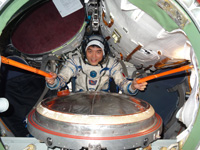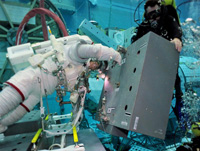JAXA Astronaut Activity Report, September, 2014
Last Updated: November 20, 2014
This is JAXA’s Japanese astronaut activity report for September, 2014.
Astronaut Kimiya Yui's training at the JSC for a long-duration ISS mission
Astronaut Kimiya Yui, who was assigned as a crew member for the Expedition 44/45 mission to the International Space Station (ISS), underwent training for a long-duration mission at the NASA Johnson Space Center (JSC.)
During the training for Extravehicular Activity (EVA) held in the Neutral Buoyancy Laboratory (NBL), which is a large pool containing a submerged full-scale ISS mockup, Yui confirmed the maintenance operation procedure for the exposed equipment installed on the ISS exterior and also practiced installing a newly developed International Docking Adapter (IDA) on the ISS. IDA is a docking mechanism developed by NASA; aiming to standardize it internationally. It will be installed to the Pressurized Mating Adapter (PMA), which was once used as the docking port for space shuttles. Prior to this EVA training, Astronaut Norishige Kanai was involved in developing this working procedure.
Other EVA training included the Simplified Aid For EVA Rescue (SAFER) operation using a Virtual-Reality (VR) system, simulating a case in which he gets off the ISS during EVA. Training for the Space Station Remote Manipulator System (SSRMS) covered the capture of unmanned visiting vehicles.
In addition, in the ISS mockup (a full-scale training facility), he simulated long hours of daily onboard tasks as well as a potential emergency response on the ISS.
Other activities included understanding the overview of scheduled experiments to be performed during his mission and obtaining his pre-flight medical baseline data for comparison with those of in- and post-flight data.
Astronaut Takuya Onishi's training in Russia for a long-duration ISS mission
Astronaut Takuya Onishi, who was assigned as a crewmember for the ISS Expedition 48/49 mission, trained for the Soyuz spacecraft and the ISS Russian segment at the Gagarin Cosmonaut Training Center (GCTC) in Russia.
During the Soyuz spacecraft training, Onishi received lectures on the Reentry Control System, Docking Mechanism System for docking to the ISS, and a TV System comprising outboard and onboard cameras and monitors. Following the training, Onishi took an exam to confirm the required knowledge and techniques had been acquired.
The Reentry-Control System in particular is an important system that controls deorbit burn to reentry, and landing on Earth. As well as nominal operations, he learned how to respond if the main engine were to fail and return to Earth in case of an emergency.

Onishi trains for emergency situations in the Soyuz spacecraft (Credit: JAXA/GCTC)
Onishi also underwent a simulation in preparation for any emergencies that might occur aboard the Soyuz spacecraft. Attired in Sokol training suits, Onishi used the full-sized Soyuz spacecraft simulator to deepen his understanding of the Life-Support System.
Other training regarding the Soyuz spacecraft included the manual docking procedure to the ISS and Soyuz relocation procedures.
For the Russian segment, he trained for the Onboard Complex-Control System, Thermal-Control System, and Power-Supply System and familiarized himself with the daily commodities equipped in the module. He also took an exam for the Onboard Complex-Control System to confirm his understanding.
Astronauts Soichi Noguchi and Akihiko Hoshide participate in the design evaluation of KOUNOTORI's Exposed Pallet
At the NASA JSC, Astronauts Soichi Noguchi and Akihiko Hoshide participated in a test to evaluate the newly designed Exposed Pallet (EP) of the HII Transfer Vehicle (HTV) KOUNOTORI.
The evaluation test was held from September 24-26, using the large pool in the Neutral Buoyancy Laboratory (NBL.) Including Noguchi and Hoshide, a total of six astronauts participated.

Noguchi simulating a battery removal (photo courtesy of Soichi Noguchi (https://twitter.com/Astro_Soichi))
One of the tasks on the ISS involves removing existing batteries and replacing them with new and improved batteries. KOUNOTORI’s EP has been redesigned to facilitate more effective transportation and replacement. Batteries transported aboard KOUNOTORI’s EP are relocated to the ISS by EVA crews and SSRMS operations.
This evaluation test of the new EP was held from the astronauts’ perspective.
Noguchi and Hoshide donned an Extravehicular Mobility Unit (EMU) for work underwater and dived into the NBL pool, simulated battery removal from the newly designed EP and confirmed the lack of any accessibility issues.
Astronauts Koichi Wakata and Soichi Noguchi attend the 27th ASE Planetary Congress. Noguchi assumes the ASE presidency.
From September 10-15, the 27th ASE Planetary Congress was held in Beijing, China; attended by astronauts Koichi Wakata and Soichi Noguchi.
From Japan, Mamoru Mohri, a former JAXA astronaut and the current director of the National Museum of Emerging Science and Innovation (MeSci), also attended.
The Planetary Congress, held most years, is hosted by the Association of Space Explorers (ASE); an organization comprising astronauts and cosmonauts from many countries. ASE works not only to contribute to space development and human space activity, but also to promote science and technology education, and raise awareness of environmental problems.

The 27th ASE Planetary Congress (Credit: Association of Space Explorers Facebook (https://www.facebook.com/
SpaceExplorers))
During the congress on September 14, Noguchi was appointed as the next ASE President, taking over from President Dorin Prenariu, whose term of office expired as of this congress. Noguchi’s term in office is one year; extendable to three years in total. During Noguchi’s presidency, as well as presiding over the ASE Planetary Congress, he will attend an annual meeting of the International Astronautical Federation (IAF) and the session of the United Nations Committee on the Peaceful Uses of Outer Space (COPUOS.)



